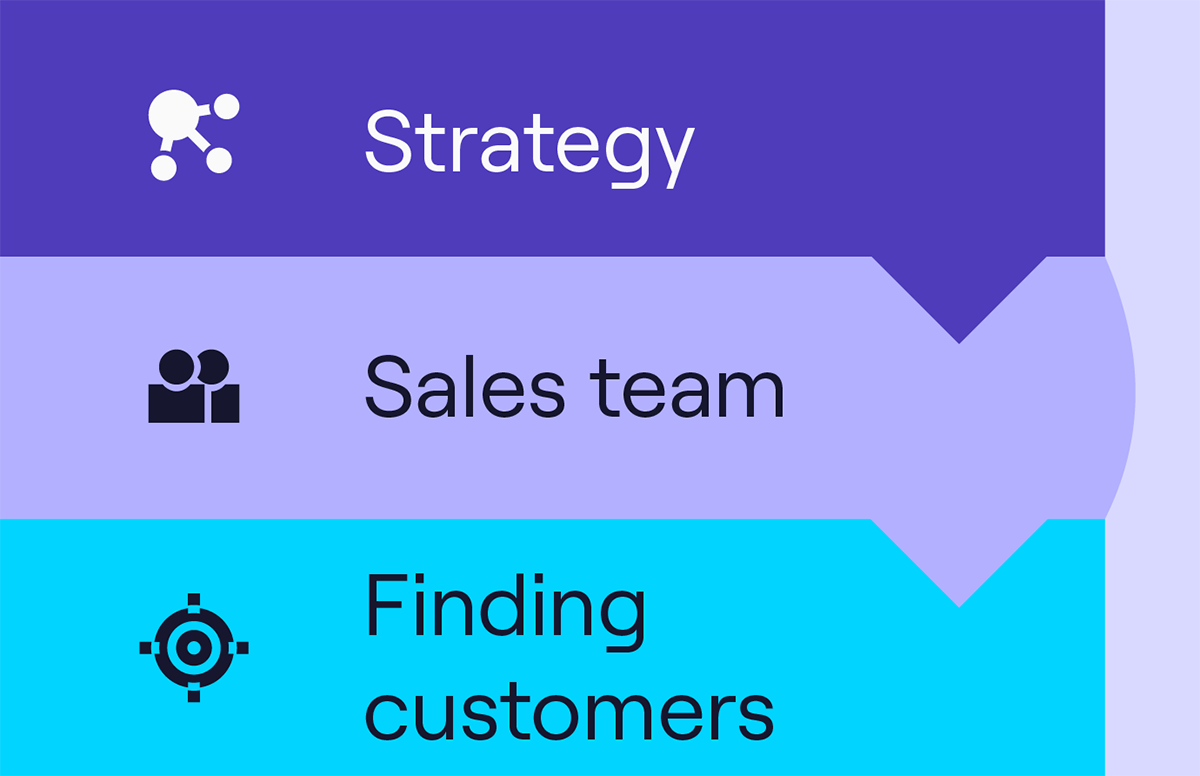7 Strategies to Beat a Summer Sales Slump
Being a quota-carrying rep ain’t easy at the best of times, but especially during the summer months when it seems everyone and their dog is away on holiday.
Endless voicemails, out-of-office emails and calls that sound like: 'sorry my signal isn't great, I'm at the top of Mount Fuji...' You might be starting to worry about meeting your target for the month.
It’s especially frustrating that you can go from booking sky-high figures one month, to slow progress the next.
But that’s just how the cookie crumbles in B2B sales. It’s a seasonal business and sometimes it feels as if prospects are nowhere to be found. And you're still waiting to fill your quota.
So if you find yourself behind on your numbers for the month, what can you do?
We asked some of Cognism’s very own SDRs, Ivana Ivanova, Emily Bollington, Stephen Maguire and Nusrat Hye, to share their priority list activities - the ones they lean on when they’re behind and need to bump up their figures.
This is what they said!
- Don’t let your mindset slip
- Set a future call task
- Focus on activity - high-quality, efficient activity
- Contact your rainy day prospect list
- Split your month into weeks
- Repopulate accounts
- Realign with your AE
1. Don't let your mindset slip
Before we get into the actionable activities, it’s important to not allow yourself to feel defeated.
So much of an SDR’s role is about consistency, dedication and drive. From a philosophical point of view, you have to keep your eyes on the prize, especially when times are tough. You need to maintain motivation in order to keep going.
Practically speaking, you’re more likely to book meetings if you have a positive vibe on the phone. As opposed to a low-energy, defeatist attitude.
So you’ve got to keep a positive mindset.
If you don’t believe you can turn it around, then you won’t. You have a far better chance if you have confidence in your ability to make it back in time.
Ivana shares:
“I was in this position last month. I was low on numbers because so many decision-makers were on holiday or unavailable when I called. But you can save a month in a week if you have the right mindset and put in the work.”
“I always follow the law of averages. So say from every 100 calls, you get one meeting, you’re not going to get that one meeting if you don’t call the 99 people who say no.”
“So it doesn’t matter if you’re having a good or a bad month, just stick to the process. I stuck to my workflow, concentrated on my preferred channels, upped my activity and made quota just in time.”
2. Set a future call task
So you’re dialling, dialling, dialling… and still dialling. Then, finally, you get through to someone and they say…
‘Sorry, I can’t talk. I’m on holiday in the South of France with my family.’
First of all, lucky for some, right?
Secondly, another brick wall. But Ivana suggests a way around this.
“They’ve answered their phone, so you know they do pick up. That’s the first good sign.”
“And while you have them on the phone, you can ask them when they’re going to be back from their trip and call them then.”
“And if they don’t tell you, then send them a quick follow-up email. If they’re away on holiday, their out-of-office reply should state when they’ll be back at work. So set up a call task for that day.”
That’s all good - but what about the people who don’t pick up the phone? What can you do about them?
Well, Ivana has another tactic. She jumps on LinkedIn.
“I’ve noticed that people reply more on LinkedIn versus email, even though they’re on holiday. So you can ask them when would be a good time to contact them when they’re back to work.”
“In July and August, I kinda forget about email. I focus my time on the phone and LinkedIn.”
3. Focus on activity - high-quality, efficient activity
Yes, okay - it’s an obvious one, but if you do more, you’re going to get more.
But that advice does come with a caveat. More isn’t always better if it’s low quality or targeting ill-fitting targets.
Stephen Maguire says:
“Some people panic when they’re behind and want their activity levels to look high to their manager. So they add anyone and everyone to their sequence - including those who don’t have contact data.”
“Doing this creates a call task that leads nowhere. It just wastes time.”
“My advice is to focus on being efficient with your time. Add more people who have contactable mobile numbers so you can have more conversations.”
Stephen tends to have the most success over the phone, so this is where he focuses his attention.
He says:
“In terms of scaling, I feel it’s easier using the phone. It can take up to 15 mins to properly personalise an email - and there’s no guarantee it won’t bounce once you’ve sent it so that time is wasted.”
Instead, Stephen has a list of cold calling steps. He prioritises phoning each of his prospects and will only email them if he can’t reach them on the phone.
That’s not to say this channel works as well for everyone. If you find you get most of your success over email or social, then you may wish to prioritise these.
Stephen adds:
“You need to work out where your skills lie and stick to your guns. So up your activity, but up the activity that you’re best at.”
It’s about knowing where your strengths lie, focusing on your best channels and having as many meaningful discussions as possible.
The more people you talk to, the more likely you are to find those looking for a solution like yours.
4. Contact your rainy-day prospect list
Here’s another trick Stephen has up his sleeve:
He maintains a spreadsheet listing all the people who have shown promise in the past.
It contains details such as:
- Whether he called them and reached their personalised voice mail.
- Confirming if he called the right phone number.
- If they answered, what the outcome of the conversation was.
Stephen says:
“So say I call someone with a good title, but they tell me it’s not a good time. Then if they don’t pick up when I try to follow up, I add them to my spreadsheet.”
“It’s like my own special cadence to work from once I’ve exhausted my other tasks. I know these people are responsive on the phone.”
“Also, most cadences allow for a day between phone calls. But if I’m behind for the month, I might shorten the gap. Especially if it’s someone who I know tends to answer the phone. They can be some quick wins.”
5. Split your month into weeks
Nusrat Hye takes a different approach. She breaks her month into weeks and allocates a target number of meetings booked.
She says:
“I give myself a target that’s 25% higher than my actual target. So even if I don’t hit my accelerator target, I’ve hopefully hit my normal target.”
“So for example, say my target is 10, I will say I need to get at least 12. And that means I need to have 3 per week to hit that target.”
Nusrat also uses this weekly breakdown to front-load her next month.
She treats the first three weeks of the month as her quota-building time. The goal is to reach target by the end of week three.
Then the final week is purely for setting up calls for the following month.
In other words, ‘front-loading’ for the next quota-carrying period.
After all, why not use a few of the extra meetings booked from a high-performing month to level out in case of a slower month?
Nusrat says:
“I learned that in my first month as an SDR. I missed my target in my ramp-up month so I was trying to find ways to reach my number.”
“I realised if I overshot the target number and set myself a goal to reach my actual target within week three, and my personal target by week four, then I made my life much easier for myself.”
“I was able to focus on the long term rather than stress about last-minute meetings to get me over the line.”
6. Repopulate accounts
Emily Bollington’s first port of call is to repopulate her accounts. She explains:
“Sometimes when you’re populating the account the first time around, you miss critical people you should be talking to, or don’t populate accounts fully.”
“So taking some time to go back and check if you’ve missed anyone important, like key decision-makers, is a good first step.”
“Then I’d focus on outreaching to those people I’d missed the first time around.”
Emily finds most of her success booking meetings comes from her LinkedIn outreach. So this is a channel she tends to focus her attention on. Especially in times when numbers are slow.
Emily explains:
“I find it more personal, and you can see when they’re active which really helps. It cuts out a lot of wasted time when you can see if someone has seen your message but not responded.”
“It’s easier to make decisions about what to do next. For example follow up, or move on.”
7. Realign with your AE
Another thing Emily does if her numbers are low is to realign with her AE.
This helps her to prioritise accounts and make the most of the time left in a month.
Emily says:
“It’s important to work closely with your AE. They can often give you pointers on where you should be focusing your time.”
It's likely your AE was successful in an SDR role in the past. So they can see the other side of the outbound sales conversation: the people who end up following through on meetings and agreeing on deals.
Never underestimate an AE’s guidance - they know the kinds of accounts that are likely to sign.
Tips and tricks from LinkedIn
Ryan Reisert, sales trainer and author, asked his LinkedIn following what they’d do first if they were missing quota.
Lots of people responded with helpful tips and tactics, and we’ve collected the best ones here 👇
1. Re-engage
Re-engage with past prospects where timing was an issue. Run a sales nav search of past users, new company. Ask for referrals. Assuming all of this hasn’t already been done.
Oh yeah and just dial!
2. Just one more
Make #onemorecall x 100
3. Control your activity
Smile and dial. Controlling your activity is all you can do.
4. Allow for seasonal change
Likely in Q3 for certain so if the target isn’t phased to allow for ups and downs during the year, an SDR should ask their Manager to change their quota structure to reflect that.
Secondly, I’m a big believer in over-achieving, so if I have a bad month I can point to past performance.
Thirdly, I also believe in sand-bagging so I am sure to have something in the bottom drawer to kick-off a new month with.
5. Buckets
Start with the hottest bucket!
6. Peer learning
Grab time with a top performer to see what’s working for them, then sync with my manager to set some SMART goals, then go execute.
7. Take a breather
Relax. Go for a walk and re-energise. Get back to my desk and work on the basics. I would think about developing my positive mental attitude.
8. Follow up
Call all your potentials first and often. You should have a pipeline of prospects who have said things like send info and call back or follow up in x timeframe.
Missing quota: final thoughts
If you’re finding the summer months slow, we feel your pain. It’s hard to catch a break when competition is rife, let alone when answer rates drop through the floor.
But any SDR worth their salt should have some tricks up their sleeve to make the numbers work. And now (hopefully) you have a couple of extra ideas to add to your list.
And at the end of the day, every sales rep has a month where they come in a little short. It’s how you attack the next month that’s important!


